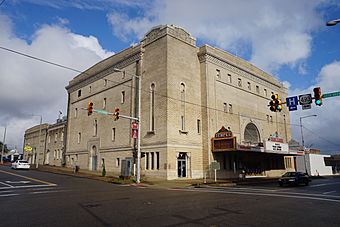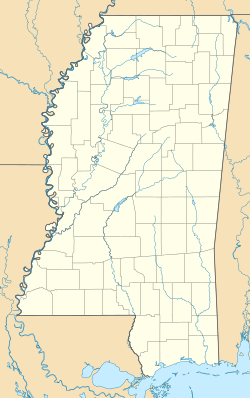Temple Theater (Meridian, Mississippi) facts for kids
Quick facts for kids |
|
|
Temple Theater
|
|
 |
|
| Location | Meridian, Mississippi |
|---|---|
| Built | 1924 |
| Architect | Emile Weil |
| Architectural style | Late 19th And 20th Century Revivals |
| MPS | Meridian MRA |
| NRHP reference No. | 79003407 |
| Added to NRHP | December 18, 1979 |
The Hamasa Shrine Temple Theater is a really old and special building in Meridian, Mississippi. It was added to the National Register of Historic Places in 1979. This means it's an important historical place!
The theater was built in a cool style called Moorish Revival. It started showing silent movies in 1928. Inside, you can see beautiful designs, marble fountains, and big bronze chandeliers. When it was first built, its stage was one of the biggest in the United States. Only the Roxy Theater in New York City had a larger one!
The Temple Theater also has a special musical instrument called a Robert Morton theatre organ. It's one of only two such organs still in their original spots in Mississippi. The other is at the Saenger Theater in Hattiesburg, Mississippi. These organs are taken care of by the Magnolia Chapter of the American Theatre Organ Society.
The Temple was first used for live shows called vaudeville and for movies. Today, it's still a busy place. People use it all year for different events, live stage shows, plays, and concerts.
Contents
Discovering the Temple Theater's Past
In the early 1920s, the Hamasa Shrine group in Meridian needed a bigger building. They hired an architect named Emile Weil to design their new home. Construction started in 1923.
The Grand Ballroom was finished in 1924. The Shriners moved in and began holding meetings there. The theater part of the building was completed a few months later. At first, only a few traveling shows performed at the Temple.
Things changed in 1927. The Shriners leased the Temple Theater to the Saenger corporation from New Orleans. The building was then changed to be a movie house. This made the Temple a very popular place!
Completing the Theater and Its Big Stage
The Temple Theater was fully finished in 1928. It had some changes, including a special Robert Morton theatre organ. As mentioned, its stage was one of the largest in the United States at that time. Only the Roxy Theater in New York City had a bigger one.
Saenger's lease was renewed in 1952 for another 20 years, ending in 1972. The Temple could seat 1800 people. The time of silent movies was very successful for the theater. Even after silent movies ended, the Temple kept entertaining guests. Many famous artists have performed there. These include George Strait, Alabama, Ronnie Milsap, Bill Monroe, Willie Nelson, The Oak Ridge Boys, Randy Travis, Roy Clark, Waylon Jennings, and Elvis Presley.
Restoration and New Ownership
In 1973, after Saenger's lease ended, the Hamasa Shrine started fixing up the Temple. They repaired plaster, repainted walls, fixed seats, and replaced carpets. The Temple kept its original look, except for one change. The lobby floor had small brass stars, swastikas, and crescents. The swastikas were just designs when the theater was built. But during World War II, they were removed.
In February 2009, a businessman named Roger Smith bought the Temple. He promised to restore it and keep shows happening all year. Many old movie theaters across the country have been torn down. But the Temple has always been used. Today, it's still used for events, live stage shows, plays, and concerts. The Hamasa Shrine group is no longer connected to the Temple Theater. They sold the building to Roger Smith and built a new Temple in Marion, Mississippi, around 2010.
Amazing Sound in the Auditorium
The way the auditorium is designed helps the sound be amazing. It has curved and smooth surfaces that make sure the sound quality is great. There's also a special room under the orchestra pit that makes instruments sound even richer. Even though the room is big and holds many people, some shows can be performed without microphones. For example, Tony Bennett performed there twice without needing a mic!
The Robert Morton Organ
The theater has a special Robert Morton theatre organ. It's one of only two of its kind still in its original place in Mississippi. The organ has a white and gold console. It has three keyboards and 32 pedals. These control 608 pipes arranged in eight groups.
The pipes are in two rooms, one on each side of the stage. Each room has four groups of pipes and different percussion instruments. These include bass and snare drums, a xylophone, and orchestral bells. There are also 12 special sound effects, called the "toy counter." These make sounds like a train whistle, car horn, and duck calls. They were used to add fun sounds to silent films.
This Robert Morton Console has 120 stops to choose different sounds and mixes. It also has 48 "pistons" that let you quickly pick a set of sounds you like. The organ was damaged by rain once. But thanks to the Magnolia Chapter of the American Theatre Organ Society, it is now fully restored and sounds wonderful!




